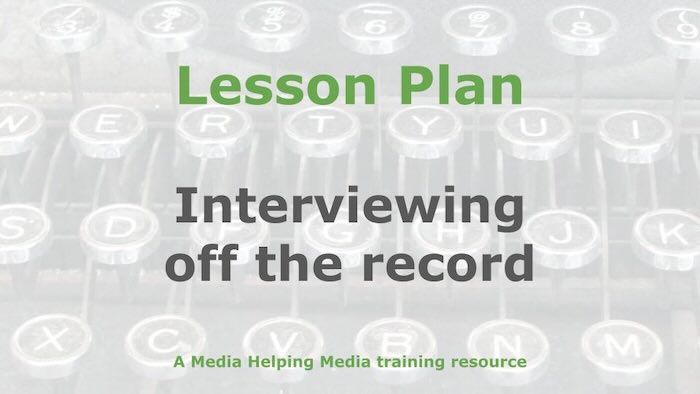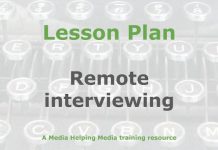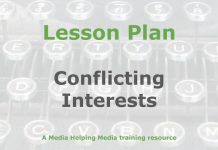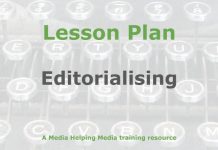 This lesson plan is designed to help journalists understand the purpose, the benefits, and the risks of ‘off the record’ interviews.
This lesson plan is designed to help journalists understand the purpose, the benefits, and the risks of ‘off the record’ interviews.
It’s based on the article Interviewing ‘off the record’ which we suggest trainers read and then share with participants before the lesson takes place. You might also want to take a look at our article on Preparing for an interview.
Introduction
In this lesson journalists will learn how to handle sources who agree to talk on condition that the conversation is off the record. This lesson will treat the off the record discussion as an informal contract. Our goal is to equip journalists with the best-practice behaviours to ensure that this contract is clear, mutual, and serves the public interest while rigorously protecting both the source and the journalist’s own professional integrity.
Over the next day, participatns will learn how to:
- Define the terms of the engagement before the conversation begins.
- Analyse the potential value against the inherent dangers of accepting restricted information.
- Implement verification techniques to treat restricted information as a lead, not a fact.
- Adhere to newsroom policies and maintain critical professional distance.
It might be worth telling participants that it’s probably advisable to inform their editor that they are about to carry out an off the record interview. However reporters might not always have time to refer up if it is a fast-moving story and they are out in the field newsgathering. But if they are planning an off the record interview about a highly significant or sensitive topic it might be best to let their editor know.
9:00 – 9:30: Introduction: The informal contract
- Welcome and aim: Introduce the session, focusing on the critical and often risky nature of restricted information.
- Discussion activity (15 minutes): Ask students: “Why would a source want to talk to a journalist but place restrictions on how the information is used?”
- Key concepts: Define the generally accepted meanings of ‘off the record’, ‘on background’, and ‘non-attributable’. Stress the importance of mutual agreement and defining terms before the conversation begins.
9:30 – 10:30: The value and the dangers
- Group task (30 minutes): Divide participants into two groups: one for ‘The Value’ and one for ‘The Dangers’ of off-the-record briefings (e.g., access to hidden info vs. manipulation).
- Presentations and discussion (30 minutes): Each group presents their findings. Discuss the balance: when is the potential value worth the risk?
10:30 – 10:45: Break
10:45 – 12:45: Best-practice behaviour: (role-playing)
- Role-playing scenarios: Students work in pairs, swapping roles as the journalist and the source.
- Focus 1 – Defining terms (45 minutes): The journalist must explicitly ask the source to define the terms (e.g., “When you say ‘background’, can I use this in my story, and if so, how can I refer to you?”).
- Focus 2 – Pushing ‘on the record’ (45 minutes): The journalist practises techniques for trying to move the information on the record later: “Can you say this publicly?”, “Can someone else confirm this on the record?”.
- Review: Discuss which strategies were most effective for establishing clarity and gaining transparency.
12:45 – 13:45: Lunch
13:45 – 15:45: Verification and newsroom policy
- Case study analysis (60 minutes): Students analyse a fictional case study involving a sensational off-the-record lead. They must list at least three concrete steps to independently verify the information (rule: treat it as a lead, not a fact).
- Debate (60 minutes): Debate the motion: “Newsrooms should mandate editor pre-approval for all sensitive off-the-record interviews.” Focus on the balance between risk mitigation, adherence to newsroom guidelines, and the need for speed.
15:45 – 16:00: Assignment introduction and Q&A
Briefing: Introduce the Decision-making memo assignment, detailing the scenario (sensitive MoD source offering information ‘on background’) and the four required components (definition, analysis of value/danger, best-practice steps, and final recommendation).
16:00 – 17:00: Conclusion and Q&A
- Summary recap: Use the value, dangers, and best practice points to recap the key takeaways.
- Final thought: Reiterate the need to maintain professional distance and the importance of independence and journalistic integrity.
- Open discussion: Final Q&A to address any remaining uncertainties.
Assignment: decision-making memo
Participants are to write a 1,000-word memo to their hypothetical editor addressing the following scenario:
- You have been approached by a senior source in the Ministry of Defence who offers to talk about a significant, but highly sensitive, shift in government policy. The source explicitly states they will only talk ‘on background’. They are offering critical context that would significantly improve your reporting.
Your memo must:
- Define what ‘on background’ generally means, and what you would specifically clarify with this source before proceeding.
- Analyse the potential value and dangers of accepting the interview on these terms.
- Outline the best-practice steps you will take during and after the interview, focusing on independent verification and attempts to move the information ‘on the record’.
- Conclude with a clear recommendation to your editor on whether or not the interview should proceed, justifying your answer.
Related articles








